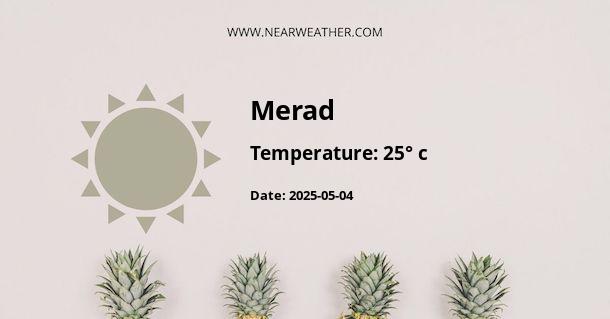Climate and Weather in Merad, Algeria
Merad is a small town located in the Mascara Province of Algeria. Situated in the northwestern part of the country, Merad experiences a Mediterranean climate, characterized by hot, dry summers and mild, wet winters. The town is known for its beautiful landscapes and agricultural activities, which are heavily influenced by the local climate. In this article, we will explore the climate and weather patterns in Merad throughout the year.
Temperature
Merad enjoys warm temperatures throughout the year, with the hottest months being July and August. During these months, the average high temperatures range from 31°C (88°F) to 35°C (95°F), with occasional heatwaves pushing the mercury even higher. The nights provide some relief from the heat, with average low temperatures ranging from 18°C (64°F) to 22°C (72°F).
In contrast, the winter months in Merad are relatively mild, with average high temperatures ranging from 14°C (57°F) to 17°C (63°F). January, the coldest month, sees average low temperatures between 3°C (37°F) and 6°C (43°F). While snowfall is rare in Merad, occasional frost can occur during the coldest nights of the year.
Overall, Merad experiences a significant temperature difference between summer and winter, creating distinct seasonal variations in the town's climate.
Precipitation
Merad receives its highest amount of rainfall during the winter months, particularly from November to February. The town experiences an average of 400 to 600 millimeters (15.7 to 23.6 inches) of rainfall annually, with December being the wettest month. This precipitation is crucial for the region's agricultural activities, as it supports the growth of crops and vegetation.
During the summer months, Merad experiences very little rainfall. The months of June, July, and August are particularly dry, with less than 5 millimeters (0.2 inches) of rainfall on average. This dry period, combined with high temperatures, can result in drought conditions if the rainfall is insufficient.
Wind
The town of Merad is also known for its strong winds, which are most prevalent during the spring and summer months. The winds are influenced by various factors, including the Mediterranean Sea, the Atlas Mountains, and the Sahara Desert. The prevailing wind direction in Merad is from the northwest, but it can vary throughout the year.
These winds, known as the "Sirocco" or "Chergui," can bring warm and dusty conditions to the region. They can also contribute to the spread of desert dust and sand, reducing visibility and impacting air quality.
Sunshine
Merad enjoys a high amount of sunshine throughout the year. The town experiences an average of 9 to 10 hours of sunshine per day during the summer months, providing ample opportunity for outdoor activities and enjoying the region's natural beauty. Even during the winter months, Merad still receives around 6 to 7 hours of sunshine per day.
Climate Change
Like many other regions around the world, Merad is not immune to the effects of climate change. Rising temperatures and changes in precipitation patterns can have a significant impact on the town's agriculture and water resources. It is crucial for local authorities and communities to adapt and implement sustainable practices to mitigate the risks associated with climate change.
Conclusion
Merad experiences a Mediterranean climate characterized by hot, dry summers and mild, wet winters. The town's temperature, precipitation, wind, and sunshine patterns contribute to its unique climate. Understanding these climate characteristics is essential for residents and visitors alike, as it helps inform agricultural practices, outdoor activities, and overall planning in the region.
A - Merad's Latitude is 36.474770 & Longitude is 2.426240.
A - Weather in Merad is 12° today.
A - Climate Conditions in Merad shows overcast clouds today.
A - Humidity in Merad is 93% today.
A - Wind speed in Merad is 3.67 km/h, flowing at 58° wind direction. today.
